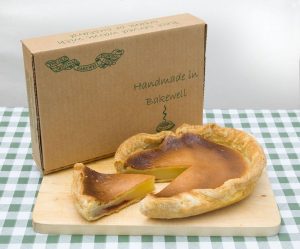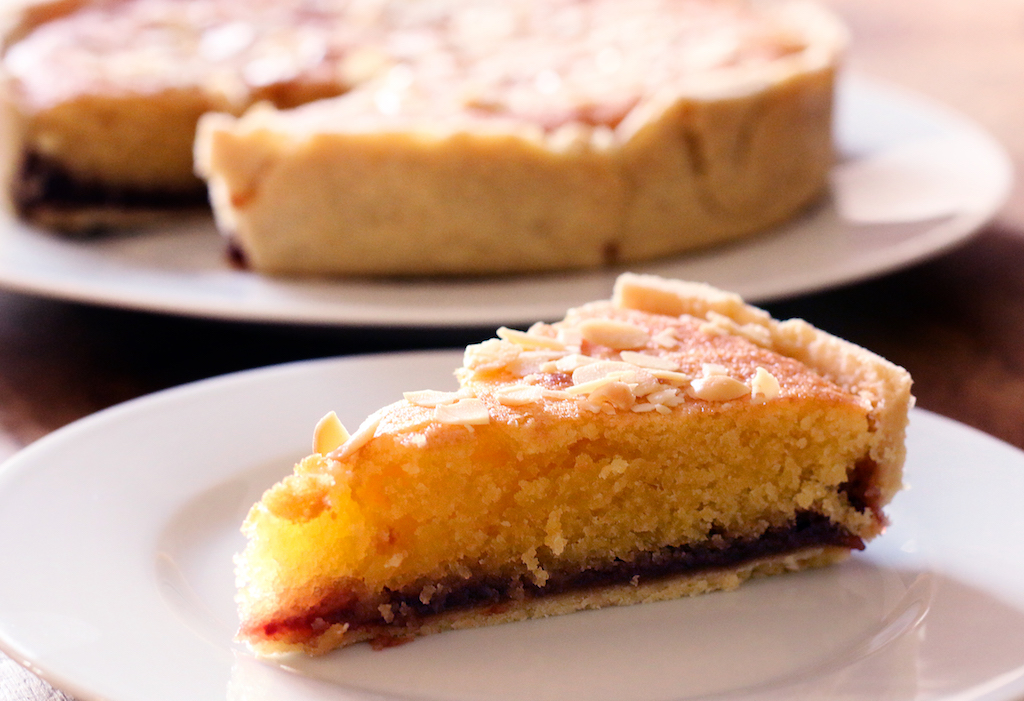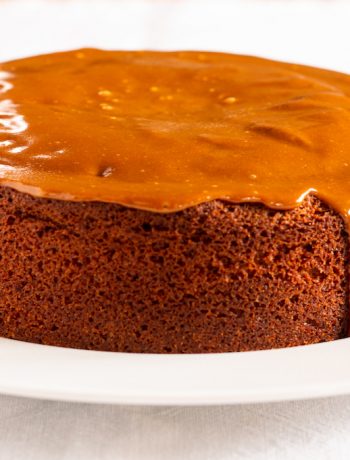It is not often that the Guardian’s Felicity Cloake gets her research wrong, but in her article on the ‘perfect Bakewell tart’ she makes a glorious Horlicks of the differentiation between a Bakewell tart and a Bakewell pudding. While to some, this may sound like semantics, to anyone who has seen both of these confections side-by-side it is an incomprehensible error that is no different to calling roast beef and onion gravy served in a Yorkshire pudding a ‘meat pie.’
Understanding the difference between the two desserts is particularly important for anyone who attempts to work out where they came from.
First of all, Bakewell is a town in Derbyshire about 20 minutes from where I live. I have been there many times and have tried both Bakewell tarts and Bakewell puddings. The tart is a risen frangipane in a shortcrust tart case with a fruit base. Variations add icing sugar, and sometimes even a fully iced topping with a cherry in the centre (a ‘cherry Bakewell’ or a ‘Bakewell cake’). The Bakewell pudding is an altogether more rustic affair of pan-baked puff pastry with a jam and custard filling. It is this puff pastry that tripped up Ms Cloake in her dissection of the dish. Puff and custard = pudding; shortcrust and frangipane = tart. The only commonality is in the order of construction (pastry, fruit, filling).
The pudding is thought to originate in Bakewell itself, and its slightly disasterous-looking presentation is probably one of the reasons it has not spread much further along the A6.

An original Bakewell pudding. Photo The Old Original Bakewell Pudding Shop
According to the Old Original Bakewell Pudding Shop, the pudding was invented at the White Horse Inn (now the Rutland Arms) during a miscommunication between the inn mistress Mrs Greaves and her cook. The instruction on the order of assembly of a strawberry tart was misheard, and the jam ended up on the bottom. Greaves served the dish anyway, and the Bakewell pudding was born. A local called Mrs Wilson saw the commercial opportunity of the pudding and started to make and sell them from her house. Her house is now the Old Original Bakewell Pudding Shop, and you can visit, buy a pudding, or even make one yourself (booking essential).
The origin of the tart is less certain, and it is confused by a piece on Information Britain that attributes the Greaves story to the tart. Even Bakewell’s own web page makes a bold attempt to deliniate the recipes, and ends up throwing mud back over the picture with the very annoying:
“The name only became common in the 20th Century; the dish was previously known as Bakewell Pudding.”
In Baking for Britain, bloggist Anna W describes a recipe by Eliza Acton (1799–1859) as the oldest, and it appears to be a Bakewell tart without the pastry (i.e. cooked frangipane with a jam base). Anna again does nothing to help matters by writing:
“Recipes nowadays use either puff or shortcrust pastry, and the title is either for a pudding or a tart. In this instance I really don’t think it matters too much. The original pudding has become a tart, so to my mind either name is valid.”
However, there is another relatively old recipe written by author Alison Uttley (1884–1976). Uttley lived in Lea, which is some way down the A6 from Bakewell, past Matlock. In her book Recipes from the Farmhouse she writes:
“Cover a wide shallow dish with thin puff paste. Put in it a layer of jam, preferably raspberry, but any kind will do. It should be half an inch thick. Take the yolks of eight eggs and beat the whites of two. Add half a pound of melted butter and half a pound each of sugar and ground bitter almonds. Mix all well together, and pour into the pastry case over the jam. Bake for half an hour and serve nearly cold.”
It’s here that we see a fully worked out Bakewell tart made in Derbyshire within a stones throw of the town of Bakewell and completely unconfused with a Bakewell pudding.
I suppose it might be helpful to know what I think about the invention of the Bakewell tart. If the Greaves pudding tale is to be believed, then I reckon that is where it all came from. I think that people experimented a bit with the filling first, and later the pastry – during this time, everything was probably called a pudding. Whomever first coined the term ‘Bakewell tart’ may have done so because the tart version (which will have been shortcrust pastry in line with other British tarts like the treacle tart) has similarities with the pudding in terms of construction, and this may have occurred outside of Bakewell itself, but probably not that far away given that the pudding has not spread much past the Co-op petrol station on the A6 heading out of town.
The recipe we have here is very lightly adapted from that of Felicity Cloake. It uses a food processor for much of the work, and we are using raspberry jam in deference to Alison Uttley. The sprinkled almonds give much-needed crunch, and we will leave the icing and the cherry to Mr Kipling.
The Old Original Bakewell Pudding Shop can be found at The Square, Bakewell, Derbyshire DE45 1BT, United kingdom.
Bakewell tart
Ingredients
- For the pastry:
- 140g plain flour, plus a wee bit more for handling
- 85g cold butter, plus a wee bit to grease your bakeware
- Pinch of salt
- Some refrigerated water
- For the frangipane:
- 110g butter
- 110g caster sugar
- 2 eggs
- 110g ground almonds
- 25g plain flour
- Half a tsp baking powder
- Zest of half a lemon
- To build:
- About 4 tbsp raspberry jam (third of a jar)
- A small handful of flaked almonds
Instructions
Pre-heat an oven to 190˚C. Put the flour, salt and cold butter in a chilled food processor and whizz until it resembles fine breadcrumbs. Run the processor on medium-low speed and slowly add wee bits of the cold water until the pastry suddenly balls and stays together. Do not add any more water. Wrap the pastry ball in clingfilm and refrigerate for about half an hour.
Now make the frangipane. Put the butter and sugar in a food processor and blitz until fluffy. Add the other ingredients and blitz again until evenly mixed. How easy was that?
Grease a 20–24cm tart ring and place it on a greased tray (or use a similar-sized, greased, loose-bottomed tart tin). Flour a surface and roll out the pastry to fill the ring (if the pastry is breaking up, leave it a bit to warm up slightly). Fit the pastry into the ring and allow some to drape over the edge. Scrunch up some baking paper, and spread it out in the tart case. Add some baking beans and blind bake in the oven for 15 mins. Remove the paper and beans, and then bake for another couple or so minutes to stiffen up the base. Use a sharp knife to trim the excess pastry off.
Heat the jam in a saucepan briefly so it flows a little easier. Pour it into the pastry case and spread around to make an even layer. Pour in the frangipane and spread to flattish with a silicone spatula (you do not need it dead flat as it will melt a little in the oven).
Bake the tart for 20 minutes. Remove from the oven, sprinkle over with flaked almonds and return to the oven for another 5 minutes.
Remove the tart from the oven and allow to cool completely before releasing from the tin.




 (34 votes, average: 3.91 out of 5)
(34 votes, average: 3.91 out of 5)


No Comments